The Anencéphale de Vichy
|
We must not treat the unknown as known and too readily accept it; and he who wishes to avoid this error—as all should do—will devote both time and attention to the weighing of evidence.
—Cicero
De Officiis, Book 1, 6 |
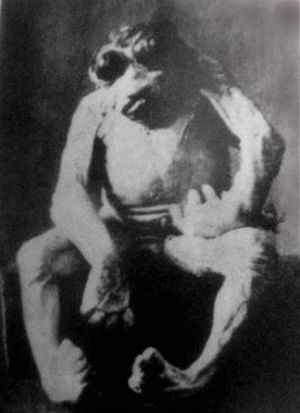 The anencéphale de Vichy. Doctors alleged that this specimen, born to a 16-year-old girl in Vichy, France in 1897, was an ape-human hybrid.
The anencéphale de Vichy. Doctors alleged that this specimen, born to a 16-year-old girl in Vichy, France in 1897, was an ape-human hybrid.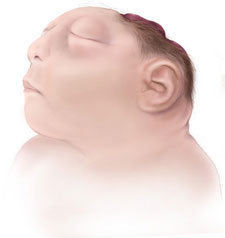 A typical anencephalic infant. Image: CDC.
A typical anencephalic infant. Image: CDC.
The anencéphale de Vichy was an alleged ape-human hybrid born to a 16-year-old girl in Vichy, France in 1897. An anencéphale, in English, is an individual affected by anencephaly (“an-en-SEF-uh-lee”), a serious birth defect in which a child, or the young of any animal, is born without parts of the brain and skull.
Although the present case was in fact originally described as an ape-human hybrid, it has never been genetically verified as such. So the Vichy birth may well have been simply an anencephalic infant that was not a hybrid of any kind. The Centers for Disease Control and Prevention (CDC) estimates that each year, about 3 pregnancies in every 10,000 in the United States will produce a child affected by anencephaly, an average of about 1,200 such births each year.
But the CDC also says that the causes of anencephaly are unknown. Not only the CDC, but scientifically informed people everywhere describe anencephaly as a “developmental disorder” (obviously!) with various possible (but unknown) causes. The potential causes typically mentioned are:
- “genetics” (that is, some unknown mutation);
- “dietary deficiency” (that is, some unknown nutriment the mother failed to eat while pregnant);
- “a medical condition” (that is, some unknown disease);
- exposure to “pollution” (that is, some unknown toxin the mother ingested while pregnant).
A simple way to describe the “educated” explanation, then, is to say “It could be a lot of things that cause it, though we don’t know what exactly. But only an ignorant fool would even consider the idea that it might be hybridization!” So in the Vichy case, given that no one really knows what the causative agent actually was, we are free to consider the idea that it might in fact actually have been hybridization.
First, lets consider the possibility that the observed anomalies resulted from a human female mating with an ape (as opposed to other animals with whom a human might hybridize).
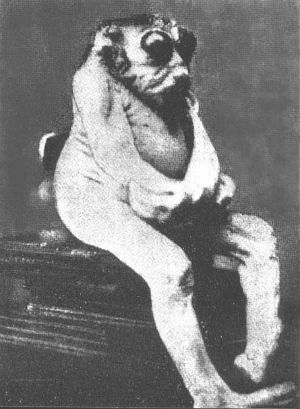
On January 6, 1897, a 16-year-old girl in the public maternity hospital in Vichy, produced an infant of indefinite sex that died a few moments after birth. Its spinal canal lay open as far down as the lumbar vertebrae and no brain was present, for which reason it became known as “L’anencéphale de Vichy.”
Together with Dr. Louis Bounoure, a professor of biology at the University of Strasbourg, Dr. Amie Therre, the head physician of the hospital, wrote an account of this birth, L’Anencéphale à type simiesque de la Maternité de l’hôpital civil de Vichy. In it they state that
The secret of the monster’s origin is in the presumed coupling of a strong and healthy sixteen-year-old girl of French nationality, with a young African anthropoid.
When questioned by the midwife and by ourselves alone and at length, she would say nothing about any sexual relations she may have had with this ape. She did, however, admit having lived in familiar association with him.
Also discreet inquiries in the vicinity of the place where the father—an individual who traveled from town to town—had parked his wagon confirmed that the father, daughter and ape all lived together in the wagon and that no other person consorted with them. [Translated by E. M. McCarthy]
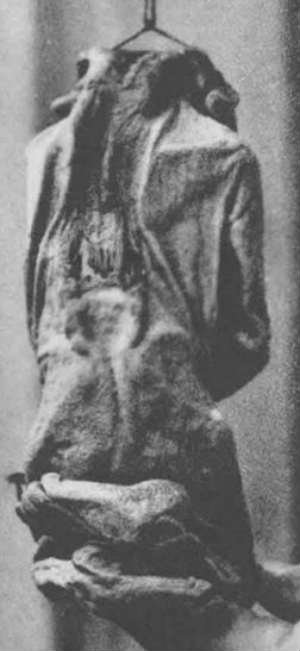 Posterior view.
Posterior view.
Beyond the circumstances just described, Bounoure and Therre thought this was a ape-human hybrid because the specimen had certain ape-like traits (see below). These facts led them to conclude that “It seems beyond doubt that an explanation in terms of simian parentage should be invoked” (Translated by E. M. McCarthy. Original French: “il ne nous semble pas douteux que la fécondation simiesque puisse être invoquée.”).
The infant was 44 centimeters (17 inches) long. Its eyes were huge and bulging. Its thorax and extremities were, according to Bounoure and Therre, proportioned like those of an ape. They also asserted that its flat nose and large ears were ape-like traits. The organs of generation were hermaphroditic.
“And beyond these many malformations,” they wrote, “that which is most striking on initial view of this infant is its frankly simian aspect, above all in the proportions of its long limbs.” (Translated by E. M. McCarthy. Original French: “En dehors de ces malformations, ce qui frappe à première vue c’est son aspect franchement simiesque surtout par ses membres démesurément longs.”).
And yet, despite all these claims, the case for this specimen being an ape-human hybrid is anything but solid. The greatest doubt in connection with Bounoure and Therre’s allegation arises from the fact that other cases are known, in which the infant was of a similar appearance, but in which no connection with an ape is alleged or even mentioned. Although these other cases are of unknown etiology, as the CDC points out, they do tend to undermine the good doctors’ argument.
Article continues below
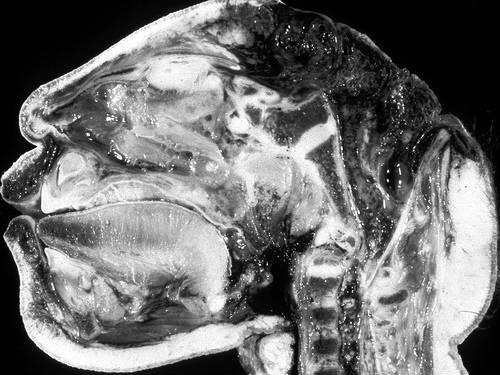 Sagittal cross-section of an anencephalic’s head
Sagittal cross-section of an anencephalic’s head
Early Cases
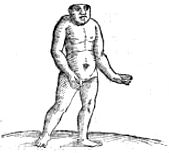 Lycosthenes’ figure
Lycosthenes’ figure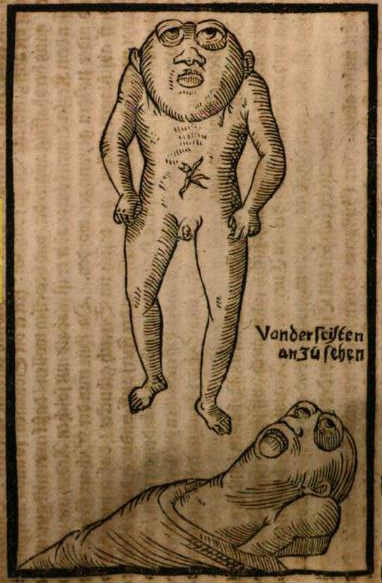 A child born at Bischheim in 1633 (Franci 1633, p. 51).
A child born at Bischheim in 1633 (Franci 1633, p. 51).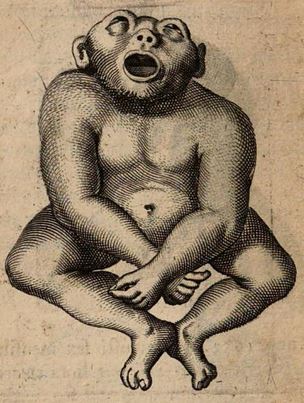 Van Meekeren’s anencephalic
Van Meekeren’s anencephalicThere are also early cases of anencephaly reported from Europe before anthropoid apes were known there. So if such births are somehow due to hybridization, some cross other than ape × human must be invoked.
Basel. Renaissance encyclopedist Conrad Lycosthenes pictures what appears to be a similar individual (Lycosthenes 1557, p. 663), an infant born at Basel, Switzerland. And the physical description he gives of the infant, which died at birth, fits the bill.
Bischheim. Similarly, Franci (1633, p. 51) reports and pictures a birth that occurred at Bischheim near Strasbourg in 1633 that was also of this type (see image below).
Amsterdam. In his book listing various cases of medical and surgical interest, the Amsterdam surgeon Job van Meekeren (Observationes medico-chirurgicae, 1682, p. 350) pictures a female anencephalic born at Amsterdam on November 9, 1650.
Paris. An infant born in Paris in 1676 and described by Denys in the Philosophical Transactions of the Royal Society (vol. 8, p. 6157) was probably also a birth of this kind. It had bulging eyes, no forehead, and the upper part of its skull was open. Lacking a brain, it died at birth. A similar birth occurred in Paris in 1683 (Mauriceau 1694, pp. 288-289). Another such birth was reported from Amiens in 1771 (Anselin 1771).
Saint-Hilaire. Étienne Geoffroy Saint-Hilaire (1826) described and pictured another anencephalic (see image below) as well as, more briefly, a variety of other such cases that had been previously reported. His specimen was an Egyptian mummy that was at least 2,000 years old.
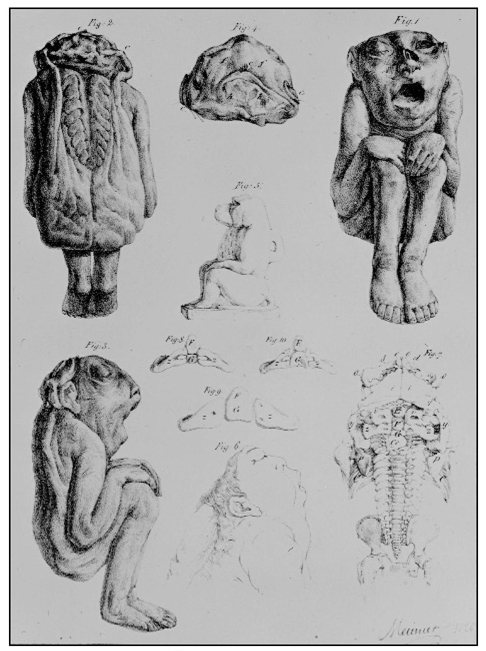 Geoffroy Saint-Hilaire's anencephalic, a mummy discovered by Giuseppe Passalacqua at Tuna el-Gebel, the necropolis of Khmun (Hermopolis Magna). Source: ||y69t4oxy.
Geoffroy Saint-Hilaire's anencephalic, a mummy discovered by Giuseppe Passalacqua at Tuna el-Gebel, the necropolis of Khmun (Hermopolis Magna). Source: ||y69t4oxy.
Anuran-human hybrids?
In its traits, the Vichy birth corresponds much better with various alleged hybrids between humans and anurans (frogs and toads) than with what has been described for ape-human hybrids. Many of these so-called frog babies also are anencephalic, though some, too, are reportedly viable. At any rate, anyone interested in the origins of the anencéphale de Vichy would do well to compare its characteristics with the specimens described in the reports collected under the heading of frog × human, especially with those specimens in which human, rather than anuran characteristics, proponderate.
By the same author: Handbook of Avian Hybrids of the World, Oxford University Press (2006).